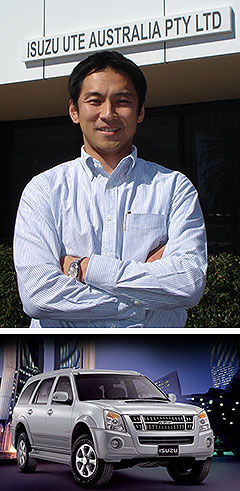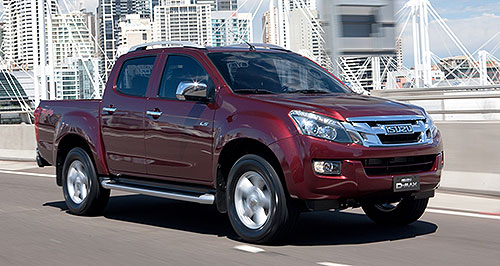Make / Model Search
News - IsuzuIsuzu investigating eco optionsDownsized D-Max: A smaller engine will end up under the bonnet of Isuzu’s D-Max ute from 2016, but the company is busy investigating numerous eco alternatives. Downsized diesel, CNG engines and more GM collaboration on Isuzu agenda3 Dec 2012 By HAITHAM RAZAGUI in BANGKOK ISUZU wants to develop a small-displacement engine for vehicles such as its D-Max one-tonne ute in response to tightening global emissions and fuel consumption standards – and already has a 2.5-litre engine ready for when Euro 5 becomes mandatory in Australia in 2016. Engines that run on compressed natural gas (CNG) are also on the agenda, as are hybrid drivetrains for its heavier vehicles. A third vehicle line to supplement the D-Max and upcoming MU-7 SUV is also desired, but a return to passenger vehicles such as the Gemini (1974 to 2000) and Piazza (1981 to 1992) has been ruled out. Isuzu executives say a van to rival the Toyota HiAce and Hyundai iLoad would be a tough business case due to Toyota’s dominance of the global market. Speaking at an event in Thailand last week, Isuzu Motors International Operations managing director Shinsuke Minami told journalists the company is “trying to develop smaller engines (because) that is the trend”. Toyota bought a stake in Isuzu in 2006 and the two Japanese companies had planned to co-develop diesel engines, but that appears to be on hold as Toyota more recently announced a deal with BMW. Mr Minami dismissed reports of Isuzu’s negotiations with Volkswagen as speculation. He said Isuzu “will try to do it ourselves” rather than collaborate with another manufacturer on the downsized diesel, but said the company was open to further collaboration with former shareholder General Motors on other projects.  Left: Takeshi Kasahara. Below: Previous-generation MU-7. Left: Takeshi Kasahara. Below: Previous-generation MU-7.Nevertheless, Mr Minami said reports that GM wanted to once again become an Isuzu shareholder – and had originally proposed to buy a third of the company but was knocked back to 10 per cent by Isuzu – were just rumours. It has been reported that the GM deal would give Isuzu access to hybrid technology, which Mr Minami told GoAuto he was interested in for use on the company’s heavier trucks. He was not sure hybrid drivetrains were appropriate for the D-Max or its yet to be revealed next-generation MU-7 SUV derivative. “For that, CNG would be more viable,” he said. “Many of our markets in Asia are strong with CNG and Australia has a lot of CNG resources.” Until Isuzu develops smaller diesel engines and introduces CNG, the biggest change to the Australian-delivered D-Max drivetrain will come when Euro 5 emissions compliance becomes mandatory on all new cars locally in 2016. A 2.5-litre twin-turbo diesel engine already used in Europe and available with a six-speed manual (the 3.0-litre comes with a five-speed gearbox) or five-speed automatic will replace the current 3.0-litre four-cylinder unit. Mr Minami said there is little cost difference between the Euro 5-compliant twin-turbo 2.5-litre and EU4 single-turbo 3.0-litre diesel engines used in the D-Max because the architecture is almost identical, with the 2.5 being “shorter” but able to deliver similar performance to the larger unit due to higher fuel-injection and turbo boost pressure. Asked why Isuzu does not simplify manufacturing and parts supply by using the 2.5-litre engine for all markets, Mr Minami said that in many countries smaller engines are equated with cheapness. “The customer’s point of view is that 2.5 litres is less expensive than 3.0 litres,” he said, admitting that fuel quality can also be a factor in some markets. Isuzu’s European-spec 2.5-litre engine produces 120kW of power and 400Nm of torque, 10kW down on the 3.0-litre, but with a 20Nm advantage – although maximum torque is only available between 1400rpm and 2000rpm compared with 1800rpm-3000rpm for the 3.0. The 2.5 is around six per cent more efficient than the 3.0, consuming 7.4 litres of diesel per 100 kilometres on the combined cycle in a 4x2 single-cab D-Max, and emissions are also lower. Information remains scarce regarding the seven-seat MU-7 SUV that is pegged for Australian release some time next year. Mr Minami would only say the MU-7 name is likely to continue – the current model is an Asia-only model without Euro 4 or Euro 5 engine availability – and will be similar to the related Holden Colorado 7. He said the MU-7 will be launched with the 3.0-litre engine in Australia and ruled out the addition of a six-speed manual transmission to that engine. Isuzu wants to extend its light-truck range beyond the D-Max and MU-7, but what shape the third model will take remains to be seen. Mr Minami said Isuzu “has no technology” in the field of passenger cars, leaving a commercial van as the most likely option. However, Isuzu Ute Australia deputy managing director Takeshi ‘Kasa’ Kasahara told GoAuto the Toyota HiAce’s 50 per cent share of the global van market would make it hard for Isuzu to achieve sufficient volume. He said it would also have to be built on a ladder chassis like the D-Max and MU-7, reducing load capacity due to the necessity of a raised floor.  Read more1st of December 2012  Isuzu D-Max accessories from Australia to the worldGlobal demand for Isuzu’s Australian-developed and made official D-Max accessories18th of October 2012  AIMS: Isuzu confirms SUV for Oz in 2013Seven-seat, D-Max based Isuzu SUV heading to Australia next year – with new styling30th of August 2012  Isuzu D-Max scores four starsIsuzu still hoping for 5-star ANCAP rating for D-Max ute despite 4-star ENCAP result25th of June 2012  Isuzu on the doubleNew D-Max ute will help achieve ambitious target of doubling sales, says Isuzu boss |
Click to shareIsuzu articlesMotor industry news |











Facebook Twitter Instagram